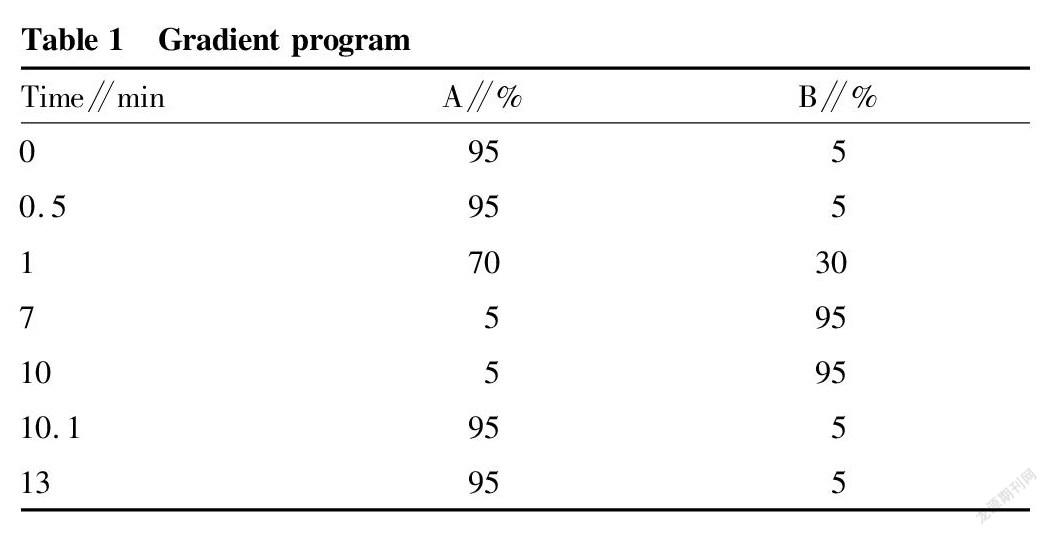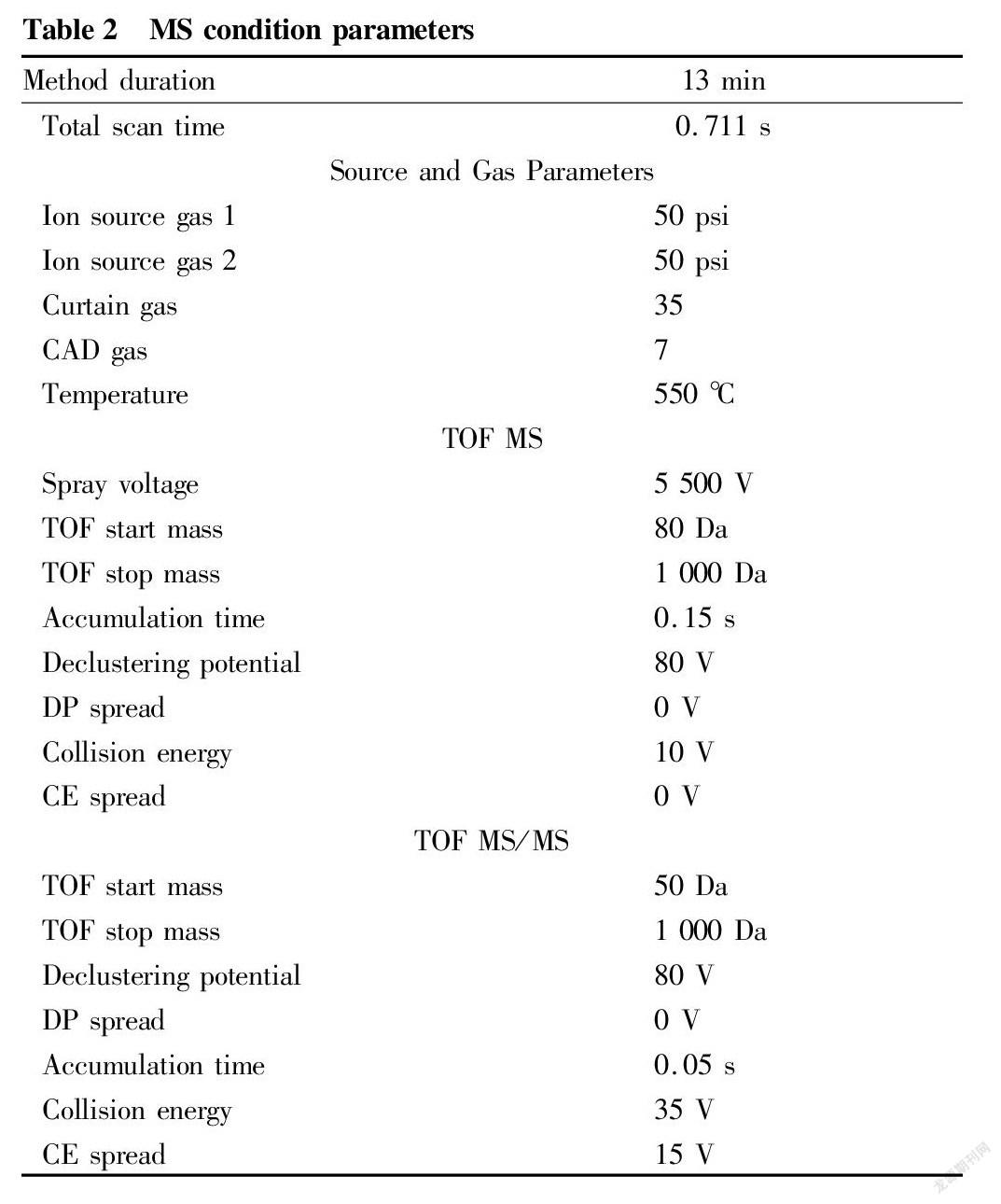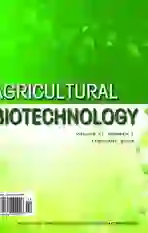Rapid Screening of 82 Pesticide Residues in Feed by Liquid Chromatography
2022-03-07YiLILumanHUOMingyangLILixueDONGLeiWANGLiwuHAO
Yi LI Luman HUO Mingyang LI Lixue DONG Lei WANG Liwu HAO





Coupled with Quadrupole-Time of Flight Mass Spectrometry
Abstract [Objectives] This study was conducted to establish a qualitative method for rapid detection of pesticide residues in feed.
[Methods]A rapid screening method for 82 pesticide residues in feed was established using ultra liquid chromatography coupled with quadrupole-time of flight mass spectrometry (UPLC-Q-TOF-MS) combined with optimized pretreatment methods.
[Results] Feed samples were extracted with 0.2% formic acid-acetonitrile solution, shaken, centrifuged, and re-centrifuged, and the supernatant was filtered with a 0.22 μm filter membrane for determination. The samples were separated on a Waters ACQUITY UPLC HSS T3 chromatographic column (2.1 mm×50 mm, 1.8 μm), and subjected to gradient elution with methanol-water solution as the mobile phase, and scanning was performed in ESI+ mode. 82 compounds could be accurately qualitatively detected in 13 min.
[Conclusions]This method is simple to operate, time-saving, and can be applied to rapid screening of large-scale feed. This study provides a theoretical basis for the development of new methods in the future.
Key words UPLC-Q-TOF-MS; Feed; Pesticide; Rapid screening method
Received: July 23, 2021 Accepted: September 30, 2021
Supported by Key R&D Project in Hebei Province (19227516D); Hebei Provincial Phase II Modern Agricultural Industry Technology System Innovation Team Building Project (HBCT2018120207); Hebei Provincial Phase II Modern Agricultural Industry Technology System Forage Industry Innovation Team Building Project (HBCT2018160403); Tangshan Science and Technology Planning Project (21130243A); The Fourth Batch of High-end Talent Project in Hebei Province.
Yi LI (1994-), male, P. R. China, engineer, devoted to research about agricultural product quality and safety monitoring.
Luman HUO (1991-), remale, P. R. China, engineer, devoted to research about agricultural product quality and safety monitoring.
#These authors contributed equally to this work.
*Corresponding author.
With the enhancement of China’s comprehensive national strength and the improvement of people’s living standards, food safety has gradually become a hot issue of public concern. The quality of feed directly affects the development of animal husbandry and human health, and feed safety is closely related to food safety. With the rapid development of animal husbandry in China, feed quality directly affects animal health. Therefore, how to ensure feed quality and safety is an important issue facing the animal husbandry industry. Feed pollution is one of the sources of pesticide residues in animals. Studies have shown that there is a problem of pesticide detection in feed[1-4].
At present, the detection methods of pesticide residues in feed include gas chromatography[5] and gas chromatography-mass spectrometry[6]. There are relatively few studies on high-throughput rapid screening methods for pesticide residues in feed. In this study, a qualitative method for rapid detection of pesticide residues in feed was established mainly through liquid chromatography coupled with quadrupole-time of flight mass spectrometry optimized pre-processing methods to establish. The method is simple to operate, time-saving, and suitable for large-scale rapid screening of feed. Meanwhile, it also provides a theoretical basis for the development of new methods in the future.
Instruments and Materials
Instruments
Liquid chromatography coupled with quadrupole-time of flight mass spectrometry (X500R): American AB SCIEX company; electronic balance (PL2002): Shanghai Mettler-Toledo company; Vortex (MS3 basic): German IKA company; oscillator ( heidolph): Heidolph, Germany; nitrogen blowing instrument; centrifuge.
Materials
Pesticide residue standards were purchased from Tianjin Alta Scientific Co., Ltd. Formic acid, methanol, and acetonitrile were of mass pure grade. The experimental water was Watsons distilled water, and other reagents were analytically pure. Feed samples were collected from Tangshan City. 0.22 μm filter membranes were purchased from DIKMA.
Experimental Methods
Preparation of standard stock solution and working solutions
10 μg/ml standard stock solution: From a mixed pesticide standard substance with a concentration of 100 μg/ml, 1 ml was drawn and diluted to 10 ml with acetonitrile to obtain a standard solution with a concentration of 10 μg/ml, which was stored in a refrigerator at -20 ℃.
100 ng/ml mixed standard work solution: From the standard stock solution with a concentration of 10 μg/ml, 1 ml was drawn and diluted to 10 ml with acetonitrile to obtain a standard solution with a concentration of 100 ng/ml.
Sample preparation
First, a 2.00 g of feed sample was accurately weighed into a 50 ml centrifuge tube, added with 1 ml of 100 ng/ml mixed standard working solution, vortex-mixed well, and prepared into a 50 ng/ml spiked sample. The mixture was then added with 20 ml of 0.2% formic acid-acetonitrile solution, shaken for 5 min, and centrifuged at 8 000 r/min for 5 min. An appropriate amount of the supernatant was drawn into a 50 ml centrifuge tube, and then centrifuged at 8 000 r for 5 min. The supernatant was filtered with a 0.22 μm filter membrane for testing.
Chromatographic reference conditions
The chromatographic reference conditions were as follows: Waters ACQUITY UPLC HSS T3 (2.1 mm×50 mm, 1.8 μm); column temperature: 40 ℃; injection volume: 5 μl; flow rate: 0.3 ml/min; mobile phase A: an aqueous solution plus 5 mmol/L ammonium formate and 0.1% formic acid; mobile phase B: methanol solution plus 5 mmol/L ammonium formate and 0.1% formic acid. The acquisition time was 13 min, and the gradient program is shown in Table 1.
MS reference conditions
Mass spectrometry conditions were as follows: electrospray ionization source (ESI), positive ion scan mode, and acquisition mode IDA. The detailed parameters are shown in Table 2.
Results and Analysis
The detection data were subjected to non-targeted qualitative analysis, and evaluated through retention time, primary mass spectra and secondary mass spectra to determine the precise mass-to-charge ratios of non-target compounds and the relative ion abundance ratios of isotope peak shapes. Possible compounds were inferred by the accurate mass information obtained, and the compounds were confirmed by reference to standards. The results are shown in Table 3. It can be seen from Table 3 that 82 kinds of pesticide residues could be well detected, and the library matching scores were between 74.8 and 100 points, of which 90% were above 90 points. Some compounds showed low matching scores, which might be related to the concentrations of standards and the extraction effects, but it did not affect the test results. From the point of view of molecular mass, each detected molecular mass was basically the same as the library matching molecular mass. It could be seen from the results that this method could accurately characterize the 82 kinds of pesticides.
Conclusions and Discussion
Zhang et al.[7] developed a detection method for four organophosphorus pesticide residues in feed using acetonitrile as an extractant by gas chromatography. Jia et al.[8] developed a detection method for polyether drugs in chicken feed by using liquid chromatography-tandem mass spectrometry, using acetonitrile as an extractant. In this study, the 82 pesticide residues could be qualitatively analyzed through the optimized feed extraction pretreatment method using 0.2% formic acid-acetonitrile solution as an extraction solvent, combined with liquid chromatography coupled with quadrupole-time of flight mass spectrometry. Compared with Zhang Haifeng and Jia Tao, we optimized the extraction method and improved detection accuracy. Meanwhile, the method is easy to operate and has high accuracy, and can meet rapid qualitative analysis of a large number of feeds.
References
[1] GONG SS, GU X, CAO H, et al. Ultra liquid chromatography coupled with quadrupole-time of flight mass spectrometry (UPLC-Q-TOF-MS) for rapid screening of 14 sulfonamides in fresh milk[J]. Journal of Instrumental Analysis, 2014, 33(12): 1342-1348. (in Chinese)
[2] MENG Z, SHI ZH, LYU YK, et al. Rapid Screening of fluoroquinolones and sulfonamides in dairy products using ultra performance liquid chromatography coupled to high resolution quadrupole time-of-flight mass spectrometry[J]. Chinese Journal of Analytical Chemistry, 2014, 42(10): 1493-1500. (in Chinese)
[3] HERNANDEZ F, PORTOLES T, IBANEZ M, et al. Use of time-of-flight mass spectrometry for large screening of organic pollutants in surface waters and soils from a rice production area in Colombia[J]. Science of the Total Environment, 2012(432): 249-259.
[4] WU YS, SUN DD, LI JG, et al. Survey on multiple pesticides residues in cow feed[J]. Food Safety and Quality Detection Technology, 2019, 010(11): 3273-3279. (in Chinese)
[5] General Administration of Quality Supervision, Inspection and Quarantine of the People’s Republic of China. GB/T 18969-2003 Determination of residues of organaphosphorus in feeds—Gas chromatagraphic method[S]. (in Chinese)
[6] General Administration of Quality Supervision, Inspection and Quarantine of the People’s Republic of China. GB/T 23744-2009 Determination of 36 pesticide residues in feedstuffs—GS-MS[S]. (in Chinese)
[7] Detection of organophosphorus pesticide residues in feed[C]//Inner Mongolia Autonomous Region Natural Science Annual Conference. 2012. (in Chinese)
[8] JIA T. Study on the detection method of polyether drugs in chicken feed by liquid chromatography-tandem mass spectrometry[J]. Feed China, 2016(2):47-49. (in Chinese)
Editor: Yingzhi GUANG Proofreader: Xinxiu ZHU
杂志排行
农业生物技术(英文版)的其它文章
- Expression Analysis of Heat Shock Protein 70 Gene in Rice (Oryza sativa L.)
- Changes in Physiological and Biochemical Characteristics of Floral Organ
- Research Progress on Lonicera japonica Thunb. Affected by Environmental Stress
- Research Progress on Genetic Diversity of Snap Bean
- Allelopathic Effects of Cedrus deodara Needle Extracts on Seed
- Development Status and Countermeasures of Passiflora spp. Seedling Industry in Qinzhou, Guangxi
